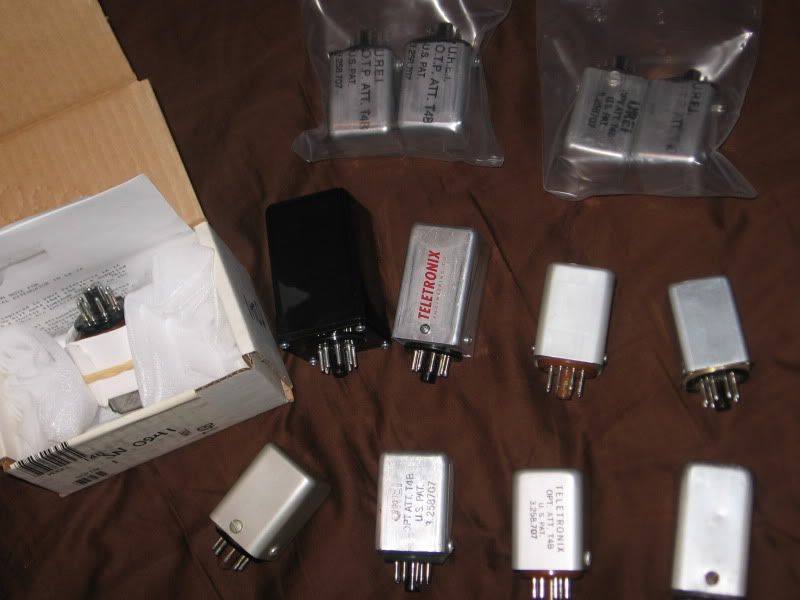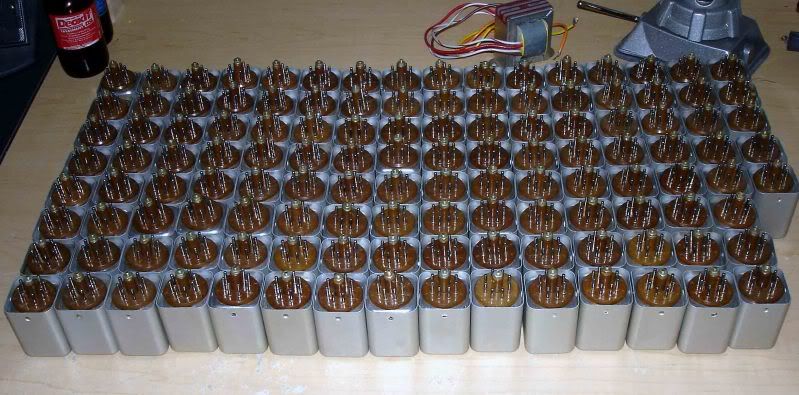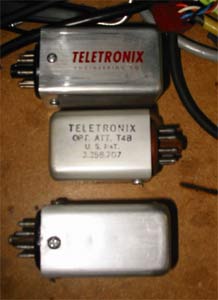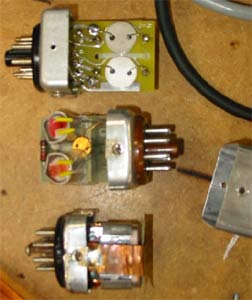SSLtech
Well-known member
...I mean, -really?

;D
Here's the scoop.
As part of working on a project, I'm having to measure and analyse the performance of the T4 modules.
In order to do this more thoroughly, I have to trace the curves from as wide an array of T4 modules as I can possibly get my hands on.
In the above picture, there's a nice array, including:
* Teletronics reissue T4 (tall can)
* Original Teletronix T4-A (tall can, with THREE photocells; 100kΩ R25)
* Original Teletronix T4-B (SHORT can, with THREE photocells; 100kΩ R25)
* Chris Jenrick T4-CJ, with two photo-cells; 25kΩ R25)
* NOS UREI T4-B
* Experimental T4 (Vactrols... R25 to be determined)
* Teletronics reissue T4 (short can)
* a selection of T4's from the JBL-Urei time period.
Also, currently plugged into the back of my LA-2a's, I have a couple of other T4's, which I'll also be measuring, comparing and evaluating.
I know that Joeelectro and a few other people have made some investigative progress with T4's in the past, but I'm really trying to make as comprehensive a study as is possible about the characteristics of T4 modules; the aging of the internal components -both the EL panel and the photocells- and any difference between photocell brands, with careful specific regard to release time and aging spread. Some are unused, others are well-used. I'm hoping to try and also see if there are any characteristics which may be age-specific irrespective of use, or 'load-specific, irrespective of age'.
now... if you want to REALLY see a lot of T4-B's... take a peep at this:

Don't get too excited though. -I DON'T OWN THESE.
These were the Bloo-T4 cases which were used years ago when Steve was selling the Bloo LA-2a kits. -All long gone now.
Keith

;D
Here's the scoop.
As part of working on a project, I'm having to measure and analyse the performance of the T4 modules.
In order to do this more thoroughly, I have to trace the curves from as wide an array of T4 modules as I can possibly get my hands on.
In the above picture, there's a nice array, including:
* Teletronics reissue T4 (tall can)
* Original Teletronix T4-A (tall can, with THREE photocells; 100kΩ R25)
* Original Teletronix T4-B (SHORT can, with THREE photocells; 100kΩ R25)
* Chris Jenrick T4-CJ, with two photo-cells; 25kΩ R25)
* NOS UREI T4-B
* Experimental T4 (Vactrols... R25 to be determined)
* Teletronics reissue T4 (short can)
* a selection of T4's from the JBL-Urei time period.
Also, currently plugged into the back of my LA-2a's, I have a couple of other T4's, which I'll also be measuring, comparing and evaluating.
I know that Joeelectro and a few other people have made some investigative progress with T4's in the past, but I'm really trying to make as comprehensive a study as is possible about the characteristics of T4 modules; the aging of the internal components -both the EL panel and the photocells- and any difference between photocell brands, with careful specific regard to release time and aging spread. Some are unused, others are well-used. I'm hoping to try and also see if there are any characteristics which may be age-specific irrespective of use, or 'load-specific, irrespective of age'.
now... if you want to REALLY see a lot of T4-B's... take a peep at this:

Don't get too excited though. -I DON'T OWN THESE.
These were the Bloo-T4 cases which were used years ago when Steve was selling the Bloo LA-2a kits. -All long gone now.
Keith




